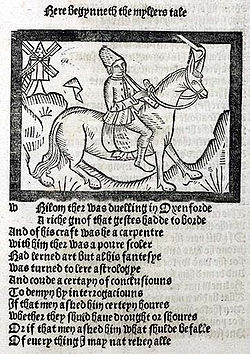Middle English
Middle English or ME[1] is an older type of the English language that was spoken after the Norman invasion in 1066 until the 1500s.[2] It came from Old English after William the Conqueror came to England with his French nobles and stopped English from being taught in schools for a few hundred years. Over this time, English borrowed several Old French words and became part of the Anglo-Norman language. This period of the development was from the High Middle Ages to the Late Middle Ages.
| Middle English | |
|---|---|
| Englisch, Inglis, English | |
 A page from Geoffrey Chaucer's The Canterbury Tales | |
| Region | England, some parts of Wales, south east Scotland and Scottish burghs, to some extent Ireland |
| Era | developed into Early Modern English, Scots, and Yola and Fingallian in Ireland by the 16th century |
Early forms | |
| Latin | |
| Language codes | |
| ISO 639-2 | enm |
| ISO 639-3 | enm |
| ISO 639-6 | meng |
| Glottolog | midd1317 |
In the 1470s, the Chancery Standard, a type of English spoken in London, started to become more common. This was partly because William Caxton brought the printing press to England in the 1470s. The type of English that people spoke in England between then and 1650 is called Early Modern English. There were many different dialects of Middle English.
Geoffrey Chaucer wrote The Canterbury Tales in Middle English.
Related pages
change- Old Scots, the northern dialect
- Middle English literature
- Mirie it is while sumer ilast, the earliest non-religious song in the English language, dating to ca. 1250 AD.
Sources
change- ↑ Horobin, Simon (2016). Introduction to Middle English. Edinburgh.
{{cite book}}: CS1 maint: location missing publisher (link) - ↑ Horobin, Simon; Smith, Jeremy J. (2002). An Introduction to Middle English. OUP USA. ISBN 978-0-19-521950-0.
- Brunner, Karl (1962) Abriss der mittelenglischen Grammatik; 5. Auflage. Tübingen: M. Niemeyer (1st ed. Halle (Saale): M. Niemeyer, 1938)
- Brunner, Karl (1963) An Outline of Middle English Grammar; translated by Grahame Johnston. Oxford: Blackwell